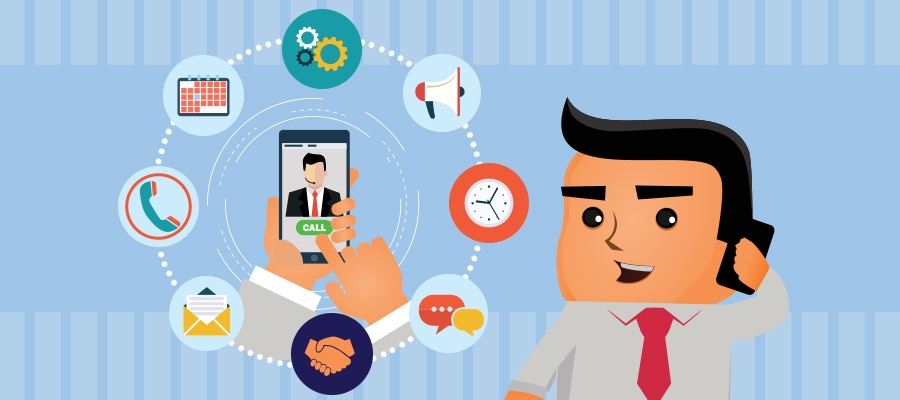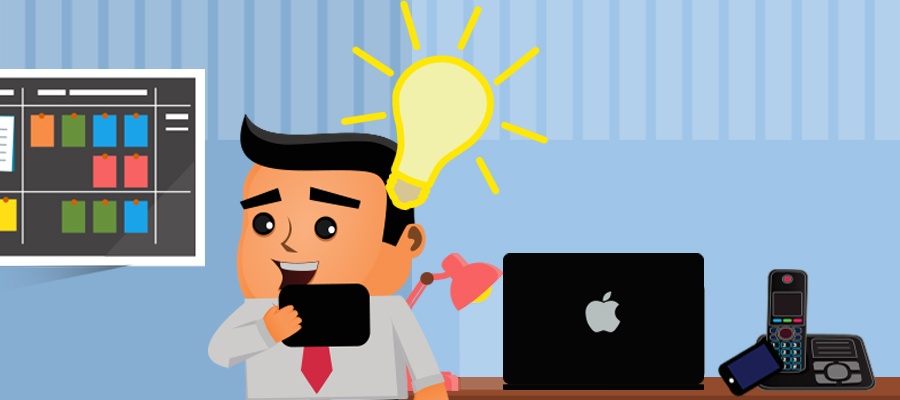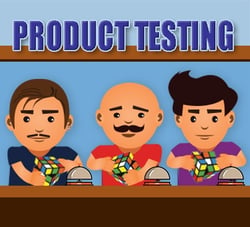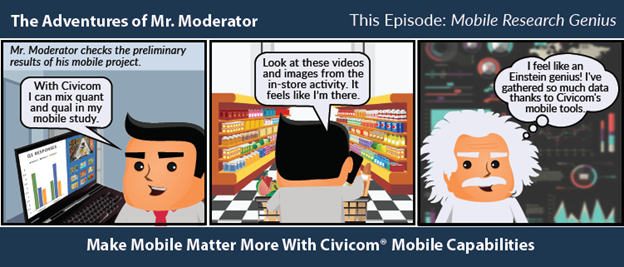There is nearly a 100% chance that you, the reader, own a mobile device. Never in the history of the world has there been an innovation that has moved so quickly to universal adoption as mobile — not even the Internet.
Mobile technologies are undoubtedly a key growth driver throughout the world. Mobile devices, particularly smartphones, make up a large percentage of mobile ownership all over the world. Mobile device usage continue to show an upward growth from users from all walks of life, even in low income populations, which suggests that mobile devices are no longer perceived as luxury items, but as a necessity. Nowadays, it is not uncommon to see everyone on the street, from businessmen to taxi drivers, using mobile devices. It has consistently demonstrated its ability to connect several people at the same time.
In this in-depth guide we will tackle various aspects of mobile market research: getting into mobile ethnography, mobile as a valuable tool for market research, and its various applications in market research methods.
Feel free to read along or navigate quickly to sections of your interest:
- Welcome to Mobile Research!
- What is Mobile Ethnography?
- Advantages of Mobile Research
- Uses of Mobile in Market Research
- Using Mobile with Other Market Research Tools
- Emerging Trends in Mobile Research
Welcome to Mobile Research!

Mobile has changed everything globally and it is changing marketing research, forever.
We are in the middle of a global communications revolution driven by mobile devices, and mobile has quickly become the leading driver of online engagement. According to comScore’s 2017 Global Mobile Report, mobile usage dominates online minutes spent by users around the globe, accounting for more than 60% of total activity online. In the United States, mobile device usage accounts for 65% of total time spent by Americans when browsing the web.
| 95% | 84% | 51% |
| of Americans are mobile phone owners1 | of American households contain at least one smartphone1 | of Americans own a tablet1 |
| 46% | of Americans say their smartphone is something they "couldn't live without"2 |
We have come to a point where using a mobile device is more than just a helpful tool. Airlines, banks, retail, and almost every industry have evolved their systems to the point where it is not only an option to use a mobile device, but actually the most practical and efficient (and potentially the only cost-free option) for engaging in transactions.
The extensiveness of market research is varied and dependent on the active participation of all respondents, which makes mobile devices the most practical and cost effective way to keep in touch with almost every segment of the population. For example, basic features of mobile phones like calling and texting do not require an internet connection, allowing access to populations with unreliable internet or are rarely online. In many countries, populations are seen to be more inclined to owning a mobile device rather than a desktop computer. Mobile devices are also intuitive which gives respondents like the elderly or even children an opportunity to take part in researches that would need their input.
Virtually every demographic group has embraced mobile services worldwide. Mobile devices are now seen as indispensable tools in data collection because these devices are carried everywhere, anywhere, all the time. Thanks to the mobile revolution, marketers and researchers now have huge new opportunities to conduct market research on mobile phones or devices and get feedback as it occurs in real time.
What is Mobile Ethnography?

The term “ethnography” has been widely associated with the marketing research industry when determining consumer behavior and preferences. It involves qualitative research into a particular society as well as the customs of individual peoples or cultures. The purpose of qualitative research in this case, as opposed to quantitative research, is to provide a full account of everyday life, behavior and practices of a particular group of people instead of statistical data. The ethnographer then interprets the data gathered and attempts to explain these findings.
Traditional ethnography involves fieldwork and requires the researcher to immerse in the community and reside among the people being studied for a length of time. Through this method, the researcher is able to glean important information from members of a particular social group or community on many aspects of the culture or customs of that group.
In marketing research, ethnography is invaluable for the information and insight it provides in brand management and marketing. It helps businesses understand how people make use of products and services.
Mobile research when applied to ethnography is a faster, more efficient way of securing data, which may take years to obtain when utilizing traditional ethnography methods. When it comes to time and context, the advantages of mobile ethnography include its provision of real-time feedback research while allowing researchers to experience consumers’ lives as they happen without the need of having to be in the same location. There are various methods of mobile ethnography; while traditional ethnography requires physical person-to-person interaction, mobile qualitative gives a window into the lives of consumer even from the other side of the world.
What are the Advantages of Using Mobile Research?

Marketing research has embraced the evolution to mobile. It's one of the first industries that's been poking through the technological evolution and has been developing creative ways to climb into the minds of mobile users.
Mobile technology has evolved so much in the past 10 years that mobile device usage, including recording audio, video, and taking pictures, has pretty much become part of everyday life. As mobile devices continue to power our daily activities and get developed, mobile as a tool for qualitative research continues to provide clearer and better insight than other traditional market research methods. Some advantages of mobile research include:
Mobile qualitative is inexpensive research; it is probably the most cost-effective research tool for today's marketers.
Researchers are able to expand their range, and the locations of the participants are no longer an issue. Market researchers can conduct remote research with respondents that have been recruited nationally, internationally, or even with respondents from a nearby or local area. It is no longer necessary for researchers to travel and devote more time to research logistics than needed. With mobile research, projects are not limited to a certain city, state or country to conduct studies. Whether the respondent lives in North America, Europe, or Southeast Asia, effective mobile research will deliver accurate results. Mobile researchers are armed with remote capabilities where they can communicate to clients and respondents effortlessly, especially with online connectivity being a dominant function of mobile devices.
An additional advantage of conducting qualitative research on mobile is the easy setup and non-intrusive implementation compared to the traditional offline, non-mobile qualitative research.
Traditional methods of marketing research require interactions with respondents in person which would most of the time be too tasking, time consuming, and intrusive. In an at-home ethnography experience, researchers would visit the respondent’s home and conduct ethnography there since they want to see how the respondent is actually using the product. However, the presence of the interviewers and possibly a video crew can significantly skew the respondent’s behavior and the ethnographic process entirely. In comparison to ethnography done on mobile, the respondent is left to their own device and there is little to no intrusion that may sway the respondent. In addition, considering that a mobile device or mobile phone is practically a neat little computer, its features and processing power present endless opportunities for researchers.
Mobile device capabilities continue to get more advanced and complex. As mobile hardware furthers in innovation, so do mobile apps that can perform sophisticated, even personalized functions for all kinds of users.
Mobile device owners turn to their phones or tablets to accomplish all sorts of tasks every day using built-in features and downloadable apps. Researchers can leverage this along with online connectivity, location services, and other built-in phone capabilities such as dialing in or text messaging.
Another advantage of using mobile for qualitative research is faster data collection. Feedback is transmitted faster in mobile research.
Intelligence gleaned from data is instantaneous; real-time delivery of different kinds of media![]() using mobile devices enhances the qualitative process. Pre-group exercises can be conducted more thoroughly by allowing researchers to monitor and guide the participants to complete the exercises. In addition, the voice-to-text functionality of smartphones, which enables participants to dictate their responses while on the go, increases the accuracy of the report in terms of the time it is sent during the course of an assigned research activity.
using mobile devices enhances the qualitative process. Pre-group exercises can be conducted more thoroughly by allowing researchers to monitor and guide the participants to complete the exercises. In addition, the voice-to-text functionality of smartphones, which enables participants to dictate their responses while on the go, increases the accuracy of the report in terms of the time it is sent during the course of an assigned research activity.
However, the immediacy and convenience of input in real time is not confined only to respondents – the interactivity feature of mobile qualitative research allows the researchers to effortlessly toss out questions or ask for feedback from respondents during the actual consumer activity, which enables the acquisition of in-depth and relevant, possibly time-sensitive data – all of which was not possible before the era of mobile qualitative research.
You can accumulate different types of detailed, contextualized qualitative data using mobile in market research.
Mobile technology allows researchers to tap into the lives of consumers more than ever before, whenever, and wherever they are—whether they are traveling, working in the office, dining at a restaurant, or shopping at the mall. The additional photos, videos and other forms of data that can be submitted helps paint the whole picture in terms of participant behavior much more than text alone. Furthermore, the ease of use of mobile phones ensures that the participants will send in their reports and observations, effectively increasing the follow through. Mobile technology minimizes the tendency of non-compliance or non-completion of the task, because the researcher can simply remind the participants about the planned activities and track them.
It is possible through mobile qualitative research to conduct follow-up research.
Participants may be given take-home activities after in-depth interviews or focus group discussions. Through these assignments, the participants may contribute additional insights about their consumer behavior, yielding more comprehensive data for analysis.
The ubiquity and practicality of mobile makes it convenient research - it is a perfect solution for market researchers.
Mobile marketing research brings businesses closer to consumers than ever before. This capability of gathering different kinds of data enhances mobile research in a way that yields findings that are much more extensive and thorough than other forms of qualitative research. It reaches out to a broader respondent base without the expense of too much time and travel. With mobile, market researchers are empowered to engage in in-the-moment research and discovery of key moments of decision through various activity options and study design opportunities, which ultimately leads to key insights businesses are looking for—getting closer to their consumers and knowing them better in order to make more accurate business decisions and introduce new innovations to the consumer experience.
Uses of Mobile in Market Research

With mobile devices, market researchers can easily conduct research and uncover insights from real-time, unadulterated responses. Mobile has enabled quick exchanges of information and researchers can engage participants through various mobile market research methods: they can send instructions, guides, and reminders, while respondents can take photos and videos, record audio diaries, write journal entries, or answer surveys. Mobile researchers can implement almost every kind of activity in real time. Researchers are enabled with advanced, customizable features that can be tailored to implement focused data gathering that is inexpensive yet efficient.
In this section, we discuss the possibilities of market research in the mobile world - the applications of mobile in market research, market research through mobile apps, and how the everyday use of mobile devices can be leveraged to capture the voice of the customer for research.
Mobile Qualitative Studies
Mobile ethnography lets you engage with respondents remotely without the intrusion of an interviewing team. Using mobile, you can get a closer look at your respondent’s environment and observe key moments of decision making without having to leave your desk.
Examples of mobile qualitative studies include shopper insights, audio diaries, and patient journeys. Respondents can report their experiences through an app with journaling activities: they can input text or record audio and video that are time-stamped and can be easily reviewed. For patient journeys, respondents can jot down their experience immediately after an attack or a condition flare-up. Respondents can also input their experiences as they undergo a clinical trial or after a medical procedure.
| Here are the tools you'll need for a successful qualitative mobile study:A mobile qualitative app compatible with all mobile operating systems for collecting richer-in-the-moment insightsActivities that are intuitive and mobile-friendlyMobile app features such as audio and video recording, geolocation for pinpointing location information, offline accessibility, and push notifications for reminding participants |
Mobile Surveys
Unlike field research where researchers find themselves handing out printed questionnaires or interviewing respondents face-to-face, using mobile surveys in market research prove to be a more efficient method in engaging participants as well as gathering and analyzing data for a study. Thanks to mobile apps, researchers can do away with pen and paper and having to re-gather and re-organize filled out materials. Smartphones and tablets allow participants to access applications where they can simply tap on a mobile device and provide responses that can be logged right away. Respondents can join and participate in mobile research surveys without having to log in to a computer or physically go out of their way just to give out their responses about a product, service or an event.
Mobile surveys can be used for:
| 1. Mall intercepts Mall-goers are invited to answer a questionnaire through a mobile device, like a smartphone or a tablet. The survey can be administered on the spot or in a designated station. Afterwards, the data gathered can be immediately uploaded online. This can be exceptionally efficient especially when surveys are being conducted in multiple locations. Researchers can simply take a look at an overview of data from all locations as it comes. |  |
| 2. Shopper insights Respondents share their decision making as they choose where to shop and why they choose to shop in their preferred store. Researchers can uncover real-time mobile shopper insight by giving respondents a link to an online survey or an app. Respondents can accomplish the questionnaire and share their mobile shopper journey as they shop or they can talk into their phone - they can share how they feel about store prices, quality, or service, providing invaluable market research shopper insights altogether. |  |
| 3. Mystery shopping The mystery shopper can use a smartphone or a tablet to write their experience as they ask about particular products, make purchases, or simply leave feedback regarding the overall store experience. |  |
| 4. Brand, product, or customer experience improvement Upon purchase, establishments like clothing boutiques, restaurants, or fast food provide a survey link or a QR code where consumers can answer an online survey about their buying experience. After the survey, respondents are given an incentive in the form of a coupon code that they can use for future purchases. |  |
| 5. Television/commercial feedback Respondents are given a number to dial in to provide their reactions to televised segments or as sequence of commercials are aired. |  |
| 6. Brand tracking research, new product testing/process development Mobile can be exceptionally useful as a new product testing tool. When testing new methods or products, establishments survey respondents on their new experience using a smartphone or a tablet before they check out. This can include a new launch, a reorganization of products, brand tracking, or a new payment system. |  |
| 7. After-event evaluation Event organizers ask for feedback from attendees of conferences, seminars, or trade shows in order to improve processes and possibly minimize future unnecessary cost. This applies especially to huge, first time held events. Organizers value after-event feedback in order to identify which elements the attendees liked, disliked, or would like to see in case of serial events. In some events, surveys are given to respondents through the event app that will log their experience right then and there. Organizers can also display a link or a QR code on posters or marketing materials that can be scanned using a mobile device so attendees can give their feedback. |  |
Mobile UX/Usability Testing
Everything is going mobile, which means there are now more reasons than ever to conduct online app usability testing to determine how apps are being used and how they impact a market.

In June 2017, comScore’s Global Mobile Report indicated that mobile devices continue to overtake desktop when it comes to digital media minutes, accounting for a total of 66% of total time spent by Americans on their devices. A GlobalWebIndex survey conducted in Q2 of 2017 shows that buying online is now mobile first. App downloads has also been increasing year after year: in 2016, consumers downloaded 149.3 billion apps on their mobile devices worldwide. This figure is forecasted to grow to 352.9 billion in 2021.
The need only increases with this unstoppable growth of mobile over desktop. Businesses joining the mobile diaspora is a no brainer — it just means that getting an authentic mobile app usability experience from the consumer’s perspective has become very important. It is vital to understand and probe how consumers navigate websites and apps on their mobile devices in real time. With mobile, researchers can listen as respondents explain their navigation activity. The interviewer can probe if there are issues with the website or app responsiveness or intuitiveness, therefore exposing issues and challenges to be resolved later on. Mobile web and usability testing is also useful to analyze a business website or an app’s competitiveness in the market.
Remote Mobile Usability Testing can be used for:
- Website development
With more and more people using their mobile devices to browse online, Google has improved its search algorithms to prioritize mobile-friendly websites. Ever since the algorithm update, mobile-friendliness has been included as a significant ranking signal. Users who browse online will more likely stumble upon relevant, better quality results that are mobile optimized. With this in mind, businesses turn to mobile app usability testing to make sure that their websites are optimized and accessible to the modern market.
- App development
App downloads by mobile users have reached hundreds of billions worldwide. In the United States alone, the share of time spent on mobile apps reportedly take up 87% of overall mobile usage, dominating mobile web use.3 Businesses in turn want to make sure that when their app hits the market, it is optimized to be intuitive, accessible, and addresses every need of their target audience.

| In order to successfully conduct mobile UX or mobile usability testing, it is vital to have:A robust online platform or solution for viewing real-time respondent behavior on their mobile deviceExtensive recruiting and tech support to ensure respondent readiness as well as support in case of technical difficultiesAudio and on-screen recording capabilities for in-depth reviewing of data afterwards |
Using Mobile with Other Market Research Tools

The advantage of working with mobile in market research is its scalability. While mobile in itself is a pretty handy tool for small, medium, or large scale research projects, pairing it with other market research tools would be helpful for an in-depth and more complete insight gathering process. Here are some market research tools that can be used hand in hand with mobile research:
Telephone or web-based interview platforms
Interviewing respondents after the fact can be useful in supplementing the data that has been gathered through mobile. Moderators can conduct telephone or online in-depth interviews where they can probe the respondents further about the answers they provided on their mobile devices. Researchers can also gather the respondents to participate in a focus group discussion, where they can share their experiences and feedback along with other respondents chiming in.
Online community platforms
Online research community platforms are ideal for long term asynchronous discussions. For studies that would have to be conducted in length, using online bulletin boards with mobile research opens up many opportunities, since you can conduct both synchronous and asynchronous discussions at the same time. Online bulletin boards are equipped with gamification tools that can help increase participant engagement as well as analytic tools for generating richer reports.
Emerging Trends in Mobile Research
Market research has a bright future ahead thanks to mobile. As mobile innovation and adoption continue to rise, more methods and tools are developed not just for the researcher, but for consumers and businesses in general. This will enable interconnectivity and richer data gathering in more ways than ever. In the years to come, we will definitely continue to discover more mobile market research trends and uncover multiple pathways for market researchers leading into growing mobile market research resources and building a richer, more robust digital toolbox.
What’s in the future of mobile?
The need for mobile optimization will carry over as mobile continues to penetrate our daily lives. Adoption and development of mobile payments will grow, potentially bringing more consumers into the mobile fold. Also included are smarter searches on mobile devices, where we see more personalized and focused search queries thanks to voice activated capabilities of built-in intelligent assistants like Siri or Alexa. Mobile app developments also continue to rise, and not just for market research; new apps keep getting smarter and more enabling in terms of fulfilling almost every kind of task. Last but not least, as data from these mobile apps continue to build up, researchers will find the increasing necessity of keeping up with the immense possibilities of big data and how they can be leveraged for effective market research strategies.

Sources:
1 Pew Research Center Survey conducted in Fall 2016
2 Pew Research American Trends Panel survey, October 2014
3 comScore, Global Mobile Report 2017
GlobalWebIndex Report on Consumer Trends 2017



